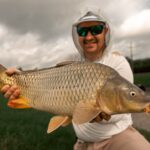
Louisiana Bull Reds Up for Harvest Again: H.B. 604 Must Not Pass
Photo Credit: Carter Abramson | Trevor Johnson Every now and then, we encounter something so
Feature Photo: Pat and Willem Berry releasing a pair of jacks off Florida’s Atlantic Coast.
It is hard to scroll the “fishing side” of social media and not discover a video of a huge giant trevally experience from the Seychelles. “Geets” are one of the most enigmatic species, commanding respect from fishermen from all walks. The international enthusiasm for GTs has been building for quite some time. However, a different domestic target now garners much of the gamefish limelight for its similar characteristics: the jack crevalle.
Inhabiting tropical and subtropical waters of the southeast Atlantic and Gulf of Mexico, jack crevalle have a sweepingly wide distribution that we currently underestimate (but more on that later). Despite their expansive distribution and perfect resume for sport fishing, Jacks historically have received little the respect they deserve. However, that is slowly changing, receiving more attention from recreational anglers, scientists, and fisheries managers alike.
Hundreds of southeast guides rely on jacks to provide a quality experience for their anglers. Some use jacks to develop new anglers’ skills, while others find relief after a tough day chasing other species. Now, a growing community of guides recognizes the groundswell of popularity, leaning into this momentum to fill their calendars. With the current status of many of our inshore fisheries and waterways, reliable species that book days are invaluable for our guides.
This change in public perception is worth noting. In the Gulf states, for example, they are both commercially and recreationally unregulated–meaning there are little to no catch limits. Take events like the Alabama Deep Sea Fishing Rodeo. The tournament started in 1929 and is now one of the largest tournaments on the planet. Historically, jack crevalle registered as one of the dozens of kill categories for the event. The tournament opened a new jack category this year and saw positive results. 159 anglers signed up for the “Jack Catch and Release Category.” 1st, 2nd and 3rd place finishers released 43/39/30 jacks, respectively. This was accomplished thanks to Dr. Marcus Draymon and the Mississippi State University’s Marine Fisheries Ecology Program working in conjunction with the Rodeo. Support from Capt. Mike Holliday and the Bajio Sunglasses team helped execute this “mindset shift,” providing sponsor and industry support that reinforced the value of the species.

Dr. Draymon and the Mississippi State University MFE Program also work with Florida International University and Texas A&M University at Galveston, NOAA and recreational fishing guides to deploy acoustic tags on Jack Crevalle. The data generated by these tags provides insight into their movement patterns and possible stock boundaries. This acoustic tagging campaign and floy tagging efforts like ASGA’s Coastal Migratory Tagging Program represent a wave of research investment to understand this valuable species. Stay tuned for the next chapter of ASGA’s jack storytelling where we will deep dive into the best available science and what we know so far!
While Jack Crevalle currently have no formal management plans, the rising tide for precautionary management and conservation of economically important species presents a real opportunity. More data will help paint a picture that gives fisheries managers the necessary framework to make science-driven decisions. It’s about time we put more respect on the mighty Jack Crevalle’s name – and we’re committed to raising the volume until we do.


Photo Credit: Carter Abramson | Trevor Johnson Every now and then, we encounter something so

This past weekend, ASGA proudly sponsored the Dirty Carp Tournament in Louisiana — and no, you didn’t misread that.

After years of data pouring in from The Albie Project, advocacy, persistence, and support from

This morning, the Connecticut Environment Committee held a hearing on House Bill 6248, a bill
We rely on our members and donations to keep fighting for a sustainable tomorrow in marine conservation.
GIVE THE GIFT OF FISHERIES CONSERVATION THIS HOLIDAY SEASON. SHOP ASGA GOODS THAT FUND FISHERIES RESEARCH & ADVOCACY CAMPAIGNS
JOIN ASGA IN CALLING FOR CRITICAL MANAGEMENT ACTION AFTER YEARS OF SPAWN FAILURES & POOR MANAGEMENT.
By using this website, you agree to our use of cookies. We use cookies to provide you with a great experience and to help our website run effectively. To learn more, please review our privacy policy.